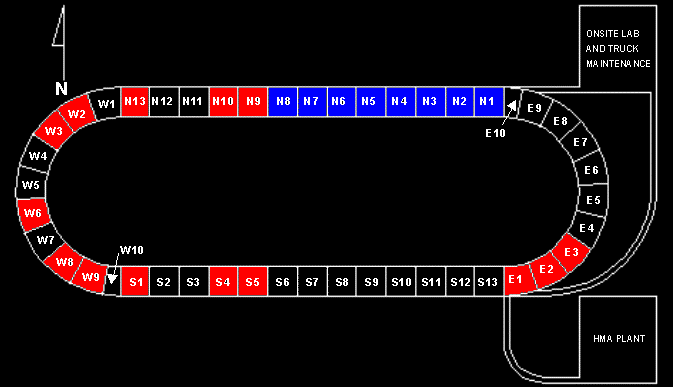|
HOTLINKS to review
upcoming NCAT training courses, query
historical weather data, view
current color radar or preview
local forecast.
1,713,861 ESALs as of 2300 hours on March 28, 2007 (17% of the 10,000,000
ESAL goal !).
RUTTING is
being measured weekly from transverse profiles using the 6-point virtual "bent
wire" method, averaging 2.1 mm on 1/3/07.
ROUGHNESS (via inertial profiler) within the middle 150 ft (research) portion
of each section averaged 79 inches per mile on 1/19/07.
CONTACT
this project via...
NCAT_Pavement_Test_Track
1600_Lee_Road_151 Opelika,_AL_36804_USA 334.844.6228

GOD BLESS AMERICA !
| |
 | Reconstruction
plans for each section are viewable by positioning your mouse over the section in
question and left-clicking. Black sections will remain in place, red sections will
be mill and inlay, and blue sections will be deep structural replacements. If you
don't already have Adobe Reader® to view this information, you can download it now for free.
|

 | Funding for
the initial construction in 2000 of the 1.7-mile oval facility, which has been built on
309 acres of land purchased by Auburn University, was
provided by the Alabama Department of Transportation
(ALDOT). Geometric design of the roadway
and architectural design of the onsite facilities was handled by David Volkert and Associates, which also served as the
construction engineering and inspection consultant for the ALDOT administered construction project. The first phase of construction was competitively
awarded to W.S. Newell and covered initial site work through completion of the subgrade. The second phase was awarded to APAC’s Couch Division and involves completion
of the pavement structure
through the experimental mixes. East
Alabama Paving completed a significant portion of work in both contracts as a
subcontractor. A state-of-the-art, 4700 square foot onsite testing laboratory and
support structures were built by W.W. Dyar.
|
 | Reconstruction activities at the Pavement Test Track were completed in
September of 2003. The 2003 experiment required milling and inlaying 14 sections
with new rutting study mixes, deep removal of 8 sections to facilitate a small
(instrumented) AASHO-like structural experiment, and continuing traffic on the remaining
sections to extend the original 2000 experiment over a second application of design
traffic (i.e., another 10 million ESALs). The reconstruction project was again
funded via a multi-state research co-op,
with pooled fund management and construction contract administration provided by the Alabama Department of Transportation. Volkert Construction Services returned to serve as the
State's CEI inspection team. When bids were opened on March 28th, East Alabama
Paving was identified as the successful contractor. Aggregate hauling began around
the first of May, with milling activities for the structural experiment initiated several
weeks thereafter. Production of hot-mix asphalt for placement on the Track ran from
July 14th to August 23rd.
|
|
![]()